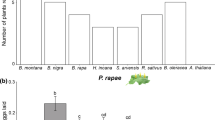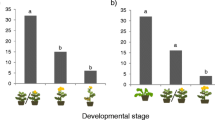Abstract
The search for and choice of oviposition sites are a key step in the life cycle of herbivorous insects. Theory predicts that natural selection should favor the discrimination ability of female insects to select between high- and low-quality oviposition sites. However, correlation between female preference and offspring performance is apparently lacking or even negative in some herbivore-plant systems. A possible explanation for this seeming failure is that most studies have focused on a single factor and spatial scale. Here, we investigated the preference-performance relationship in the seed beetle Gibbobruchus bergamini Manfio & Ribeiro-Costa (Coleoptera: Chrysomelidae). We took into account several potential factors affecting oviposition choices and larval survivorship through a multi-level approach. Hierarchical analysis that controlled for the non-independence of observations demonstrated that oviposition site choices were not related to the factors that most influenced larval survivorship. The apparent effects of other pod-feeding herbivores were greater at the plant and branch scales while at the pod level the most important factors were plant-related variables. Oviposition choices seemed to be time-constrained, meaning that females have little opportunity to further increase offspring performance through additional compensatory choices.



Similar content being viewed by others
References
Avidov Z, Berlinger MJ, Applebaum SW (1965) Physiological aspects of host specificity in the Bruchidae: III. Effect of curvature and surface area on oviposition of Callosobruchus chinensis L. Anim Behav 13:178–180
Bates D, Maechler M, Bolker B, Walker S (2014). lme4: Linear mixed-effects models using Eigen and S4. R package version 1.0-6. http://CRAN.R-project.org/package=lme4. Accessed 5 Mar 2014
Bernays EA, Chapman RF (1994) Host plant selection by phytophagous insects. Chapman & Hall, New York, p 312
Boege K, Domínguez CA (2008) Pre-dispersal seed predation reduces the reproductive compensatory advantage of thrum individuals in Erythroxylum havanense (Erythroxylaceae). Evol Ecol 22:675–687
Boggs CL (2009) Understanding insect life histories and senescence through a resource allocation lens. Funct Ecol 23:27–37
Brodbeck BV, Andersen PC, Oden S, Mizell RF (2007) Preference-performance linkage of the xylem feeding leafhopper, Homalodisca vitripennis (Hemiptera Cicadellidae). Environ Entomol 36:1512–1522
Brody AK (1997) Effects of pollinators, herbivores, and seed predators on flowering phenology. Ecology 78:1624–1631
Campbell JF, Runnion C (2003) Patch exploitation by female red flour beetles, Tribolium castaneum. J Insect Sci 3:20
Coetzee JH, Giliomee JH (1987) Seed predation and survival in the infructescences of Protea repens (Proteaceae). S Afr J Bot 53:61–64
Cornelissen T, Fernandes GW (2008) Size does matter: variation in herbivory between and within plants and the plant vigor hypothesis. Oikos 117:1121–1130
Cronin JT, Abrahamson WG (2001) Goldenrod stem galler preference and performance: effects of multiple herbivores and plant genotypes. Oecologia 127:87–96
De Menezes LCCRCR, Klein J, Kestring D, Rossi MN (2010) Bottom-up and top-down effects in a pre-dispersal seed predation system: are non-predated seeds damaged? Basic Appl Ecol 11:126–134
Delphia CM, Mescher MC, De Moraes CM (2007) Induction of plant volatiles by herbivores with different feeding habits and the effects of induced defenses on host-plant selection by thrips. J Chem Ecol 33:997–1012
Fabrikschleichach FS (2005) Selection of large host plants for oviposition by a monophagous leaf beetle: nutritional quality or enemy-free space? Ecol Entomol 30:299–306
Flaherty L, Quiring D (2008) Plant module size and dose of gall induction stimulus influence gall induction and galler performance. Oikos 117:1601–1608
Foggo A, Higgins S, Wargent JJ, Coleman RA (2007) Tri-trophic consequences of UV-B exposure: plants, herbivores and parasitoids. Oecologia 154:505–512
Fox CW, Martin JD, Thakar MS, Mousseau TA (1996) Clutch size manipulations in two seed beetles: consequences for progeny fitness. Oecologia 108:88–94
Gonz G-RH, Grez AA, González RH (1995) Resource concentration hypothesis: effect of host plant patch size on density of herbivorous insects. Ecology 103:471–474
Gripenberg S, Morriën E, Cudmore A, Salminen JP, Roslin T (2007) Resource selection by female moths in a heterogeneous environment: what is a poor girl to do? J Anim Ecol 76:854–65
Gripenberg S, Mayhew PJ, Parnell M, Roslin T (2010) A meta-analysis of preference-performance relationships in phytophagous insects. Ecol Lett 13:383–393
Hamback PA, Englund G (2005) Patch area, population density and the scaling of migration rates: the resource concentration hypothesis revisited. Ecol Lett 8:1057–1065
Heisswolf A, Obermaier E, Poethke HJ (2005) Selection of large host plants for oviposition by a monophagous leaf beetle: nutritional quality or enemy-free space? Ecol Entomol 30:299–306
Hespenheide HA (1991) Bionomics of leaf-mining insects. Annu Rev Entomol 36:535–560
Jaenike J (1978) On optimal oviposition behavior in phytophagous insects. Theor Popul Biol 14:350–356
Jaenike J (1990) Host specialization in phytophagous insects. Annu Rev Ecol Syst 21:243–273
Janz N, Bergström A, Johansson J (2005) Frequency dependence of host plant choice within and between patches: a large cage experiment. Evol Ecol 19:289–302
Janzen DH (1971) Seed predation by animals. Annu Rev Ecol Syst 2:465–492
Johnson CD, Romero J, Romero-Nápoles J (2004) A review of evolution of oviposition guilds in the Bruchidae (Coleoptera). Rev Bras Entomol 48:401–408
Kaplan I, Denno RF (2007) Interspecific interactions in phytophagous insects revisited: a quantitative assessment of competition theory. Ecol Lett 10:977–994
Krugman SL, Koerber TW (1969) Effect of cone feeding by Leptoglossus occidentalis on ponderosa pine seed development. For Sci 15:104–111
Lancaster J, Downes BJ, Arnold A (2010) Environmental constraints on oviposition limit egg supply of a stream insect at multiple scales. Oecologia 163:373–384
Manfio D, Ribeiro-Costa C, Caron E (2013) Phylogeny and revision of the New World seed-feeding bruchine genus Gibbobruchus Pic (Coleoptera: Chrysomelidae). Invert Syst 27:1–37
Mayhew PJ (1997) Adaptive patterns of host-plant selection by phytophagous insects. Oikos 79:417
Mayhew PJ (2001) Herbivore host choice and optimal bad motherhood. Trends Ecol Evol 16:165–167
Mustart PJ, Cowling RM, Wright M (1995) Clustering of fertile seeds in infructescences of serotinous Protea species: anti-predation mechanism? Afr J Ecol 33:224–229
Nakamura RR (1988) Seed abortion and seed size variation within fruits of Phaseolus vulgaris: polen donor and resource limitation effects. Am J Bot 75:1003–1010
Ostergård H, Hambäck PA, Ehrlén J (2007) Pre-dispersal seed predation: the role of fruit abortion and selective oviposition. Ecology 88:2959–2965
Pöykkö H (2011) Enemy-free space and the host range of a lichenivorous moth: a field experiment. Oikos 120:564–569
Price PW, Fernandes GW, Waring GL (1987) Adaptive nature of insect galls. Environ Entomol 16:10
R Core Team (2014) R: A language and environment for statistical computing. R Foundation for statiscal computing, Vienna, Austria. URL http://www.R-project.org/. Accessed 5 Mar 2014
Rabasa SG, Gutiérrez D, Escudero A (2005) Egg laying by a butterfly on a fragmented host plant: a multi-level approach. Ecography 28:629–639
Refsnider JM, Janzen FJ (2010) Putting eggs in one basket: ecological and evolutionary hypotheses for variation in oviposition-site choice. Annu Rev Ecol Evol Syst 41:39–57
Ribeiro-Costa CS, Costa ADS (2002) Comportamento de oviposição de Bruchidae (Coleoptera) predadores de sementes de Cassia leptophylla Vogel (Caesalpinaceae), morfologia dos ovos e descrição de uma nova espécie. Rev Bras Zool 19:305–316
Ribeiro-Costa CS, Manfio D, Bergamini LL (2014) A new species of Gibbobruchus Pic from Brazil, with new host plants and distribuition records for other Gibbobruchus species (Coleoptera, Chrysomelidae, Bruchinae). Fla Entomol 97:1085–1092
Root RB (1973) Organization of a plant-arthropod association in simple and diverse habitats: the fauna of collards (Brassica oleracea). Ecol Monogr 43:95–124
Rowe WJ, Potter DA (2000) Shading effects on susceptibility of Rosa spp. to defoliation by Popillia japonica (Coleoptera: Scarabaeidae). Environ Entomol 29:502–508
Santos JC, Silveira FAO, Fernandes GW (2008) Long term oviposition preference and larval performance of Schizomyia macrocapillata (Diptera: Cecidomyiidae) on larger shoots of its host plant Bauhinia brevipes (Fabaceae). Evol Ecol 22:123–137
Seagraves MP, Riedell WE, Lundgren JG (2011) Oviposition preference for water-stressed plants in Orius insidiosus (Hemiptera: Anthocoridae). J Insect Behav 24:132–143
Silva LA, Maimoni-Rodella RCS, Rossi MN et al (2007) A Preliminary investigation of pre-dispersal seed predation by Acanthoscelides schrankiae Horn (Coleoptera: Bruchidae) in Mimosa bimucronata (DC.) Kuntze Trees. Neotrop Entomol 36:197–202
Solomon BP (1981) Response of a host-specific herbivore to resource density, relative abundance and phenology. Ecology 62:1205–1214
Souza AJ, Santos PO, Pinto MST et al (2011) Natural seed coats provide protection against penetration by Callosobruchus maculatus (Coleoptera: Bruchidae) larvae. Crop Prot 30:651–657
Thompson JN (1988) Evolutionary ecology of the relationship between oviposition preference and performance of offspring in phytophagous insects. Entomol Exp Appl 47:3–14
Toquenaga Y, Fujii K (1990) Contest and scramble competition in two bruchid species, Callosobruchus analis and C. phaseoli (Coleoptera: Bruchidae) I. Larval competition curves and interference mechanisms. Res Popul Ecol (Kyoto) 32:349–363
Traveset A (1991) Pre-dispersal seed predation in Central American Acacia farnesiana: factors affecting the abundance of co-occurring bruchid beetles. Ecol Entomol 87:570–576
Traveset A (1993) Deceptive fruits reduce seed predation by insects in Pistacia terebinthus L. (Anacardiaceae). Evol Ecol 7:357–361
Vallius E (2000) Position-dependent reproductive success of flowers in Dactylorhiza maculata (Orchidaceae). Funct Ecol 14:573–579
Zeileis A, Kleiber C, Jackman S (2008) Regression models for count data in R. J Stat Softw 27(8)
Acknowledgments
The authors would like to thank L.B. Faria, R.D. Daud, and B.B. Santos for helpful comments on an early version of this manuscript. L.L.B was supported by Coordenação de Aperfeiçoamento de Pessoal de Nível Superior (CAPES). M.A.N received research fellowships (306843/2012-9 and 306870/2012-6, respectively) from the Conselho Nacional de Desenvolvimento Científico e Tecnológico (CNPq).
Author information
Authors and Affiliations
Corresponding author
Additional information
Edited by Angelo Pallini – UFV
Rights and permissions
About this article
Cite this article
Bergamini, L.L., Almeida-Neto, M. Female Preference and Offspring Performance in the Seed Beetle Gibbobruchus bergamini Manfio & Ribeiro-Costa (Coleoptera: Chrysomelidae): A Multi-Scale Comparison. Neotrop Entomol 44, 328–337 (2015). https://doi.org/10.1007/s13744-015-0294-5
Received:
Accepted:
Published:
Issue Date:
DOI: https://doi.org/10.1007/s13744-015-0294-5




